Page 396 of 652

To set the rating, activate the DVD Setup Menu and
follow these additional instructions:
•Using the remote control’s Left and Right cursor
buttons, select the Rating tab.
•Highlight�Change Rating�, and then press the remote
control’s ENTER button.
•Enter the current password. Select a digit, use the
remote control’s Up and Down cursor buttons to set
the value for the current digit, and then press the
remote control’s Right cursor button to select the next
digit. Repeat this digit selection sequence for all four
digits.
•After the four-digit password is entered, press the
remote control’s ENTER button. If the password is
correct, the Rating Level menu is displayed.
•Using the remote control’s Up and Down cursor
buttons, select the new rating level, and then press the
remote control’s ENTER button to accept the change.
Product Agreement
This product incorporates copyright protection technol-
ogy that is protected by U.S. patents and other intellec-
tual property rights. Use of this copyright protection
technology must be authorized by Macrovision, and is
intended for home or other limited viewing uses other-
wise authorized by Macrovision. Reverse engineering or
disassembly is prohibited.
Dolby� Digital and MLP Lossless Manufactured
under license from Dolby Laboratories. �Dolby�,
�MLP Lossless�, and the double-D symbol are trademarks
of Dolby Laboratories. Confidential unpublished works.
Copyright 1992-1997 Dolby Laboratories. All right re-
served.
394 UNDERSTANDING YOUR INSTRUMENT PANEL
Page 403 of 652
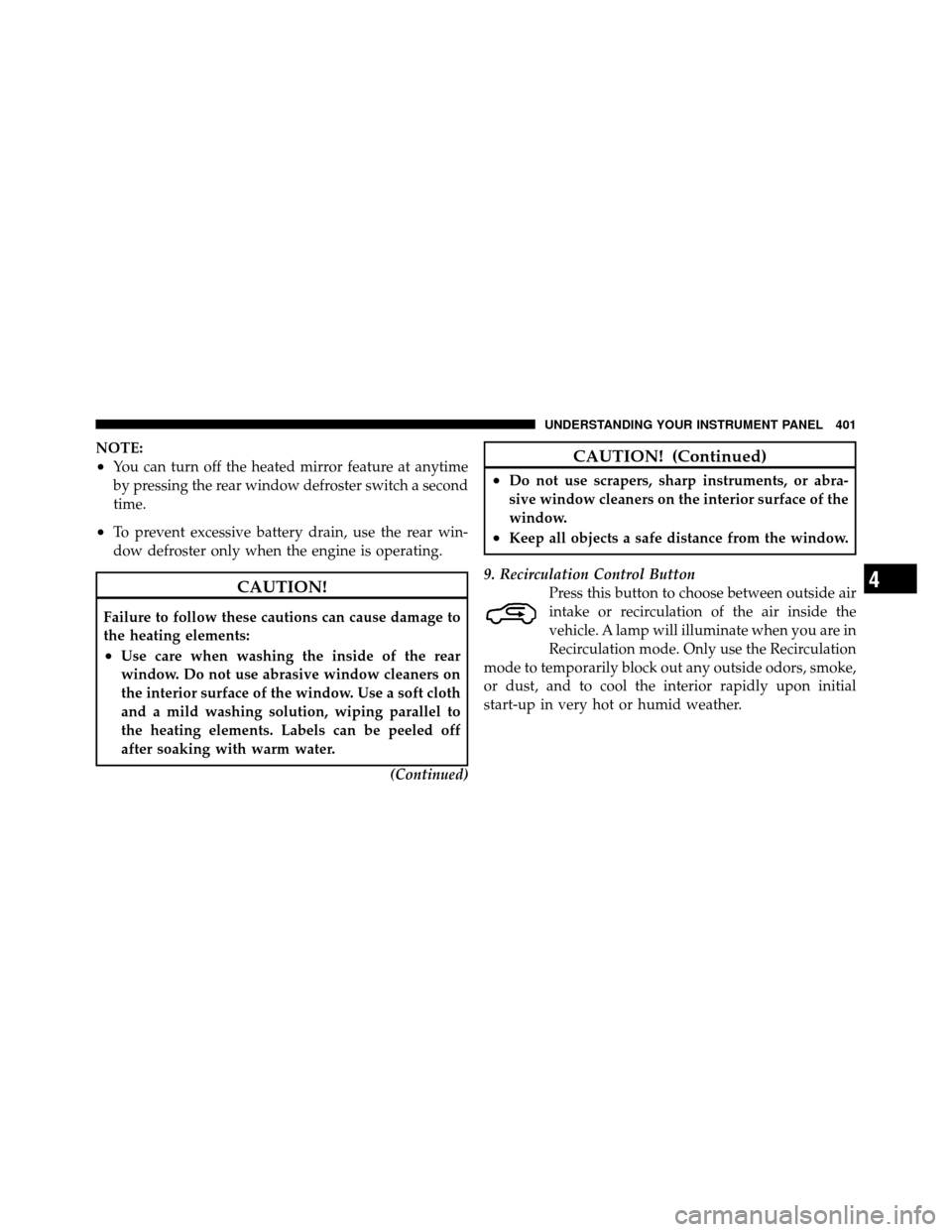
NOTE:
•You can turn off the heated mirror feature at anytime
by pressing the rear window defroster switch a second
time.
•To prevent excessive battery drain, use the rear win-
dow defroster only when the engine is operating.
CAUTION!
Failure to follow these cautions can cause damage to
the heating elements:
•Use care when washing the inside of the rear
window. Do not use abrasive window cleaners on
the interior surface of the window. Use a soft cloth
and a mild washing solution, wiping parallel to
the heating elements. Labels can be peeled off
after soaking with warm water.(Continued)
CAUTION! (Continued)
•Do not use scrapers, sharp instruments, or abra-
sive window cleaners on the interior surface of the
window.
•Keep all objects a safe distance from the window.
9. Recirculation Control Button Press this button to choose between outside air
intake or recirculation of the air inside the
vehicle. A lamp will illuminate when you are in
Recirculation mode. Only use the Recirculation
mode to temporarily block out any outside odors, smoke,
or dust, and to cool the interior rapidly upon initial
start-up in very hot or humid weather.
4
UNDERSTANDING YOUR INSTRUMENT PANEL 401
Page 413 of 652
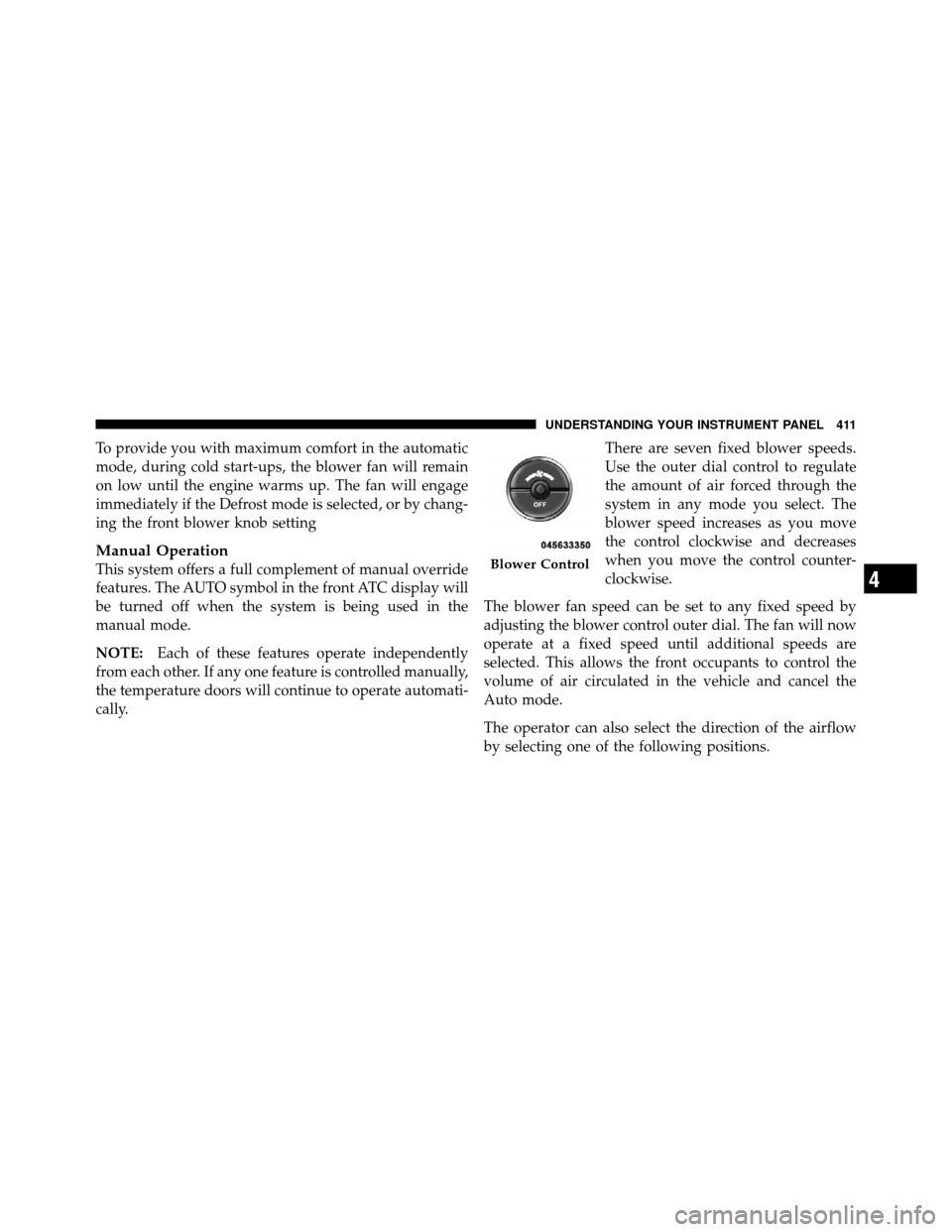
To provide you with maximum comfort in the automatic
mode, during cold start-ups, the blower fan will remain
on low until the engine warms up. The fan will engage
immediately if the Defrost mode is selected, or by chang-
ing the front blower knob setting
Manual Operation
This system offers a full complement of manual override
features. The AUTO symbol in the front ATC display will
be turned off when the system is being used in the
manual mode.
NOTE:Each of these features operate independently
from each other. If any one feature is controlled manually,
the temperature doors will continue to operate automati-
cally. There are seven fixed blower speeds.
Use the outer dial control to regulate
the amount of air forced through the
system in any mode you select. The
blower speed increases as you move
the control clockwise and decreases
when you move the control counter-
clockwise.
The blower fan speed can be set to any fixed speed by
adjusting the blower control outer dial. The fan will now
operate at a fixed speed until additional speeds are
selected. This allows the front occupants to control the
volume of air circulated in the vehicle and cancel the
Auto mode.
The operator can also select the direction of the airflow
by selecting one of the following positions.Blower Control
4
UNDERSTANDING YOUR INSTRUMENT PANEL 411
Page 419 of 652
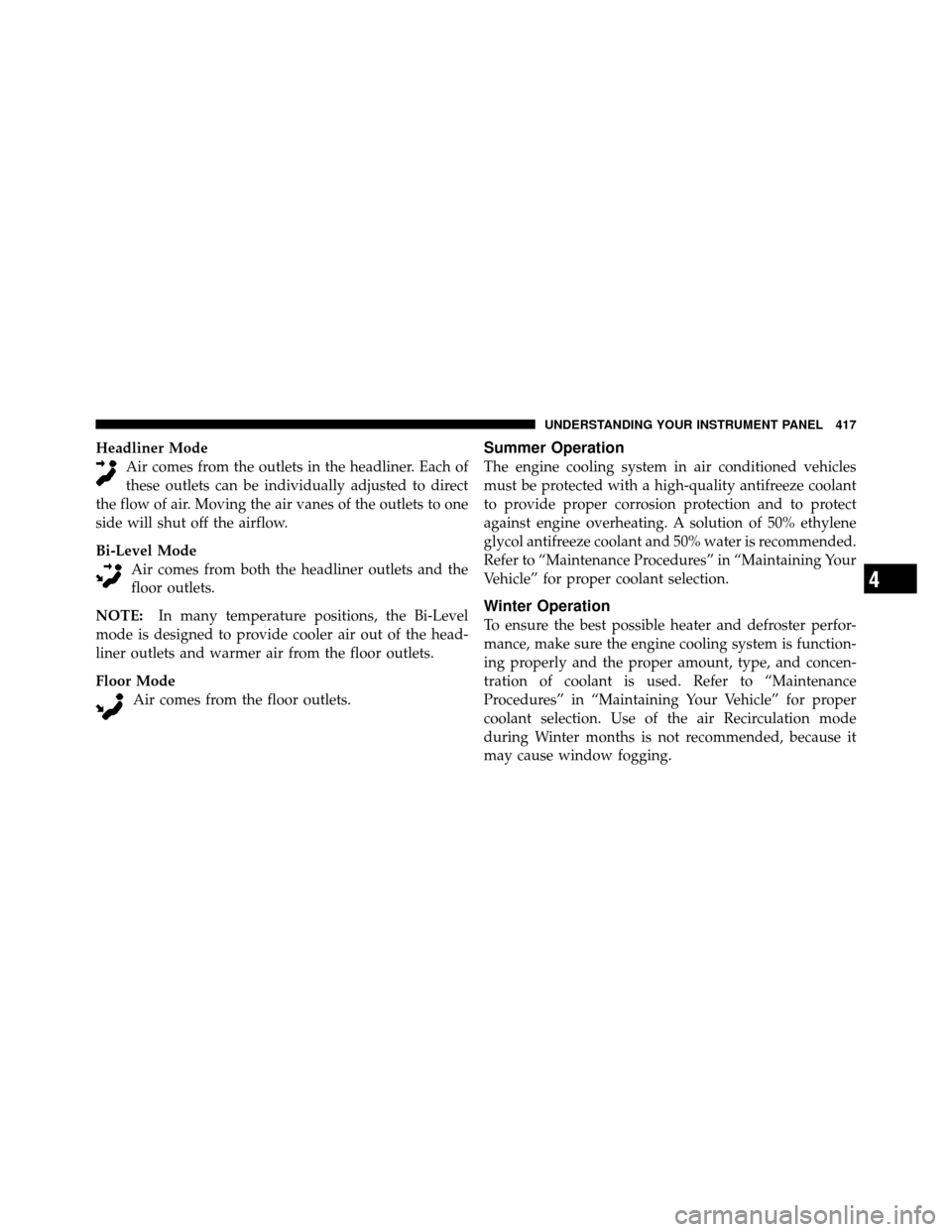
Headliner ModeAir comes from the outlets in the headliner. Each of
these outlets can be individually adjusted to direct
the flow of air. Moving the air vanes of the outlets to one
side will shut off the airflow.
Bi-Level Mode Air comes from both the headliner outlets and the
floor outlets.
NOTE: In many temperature positions, the Bi-Level
mode is designed to provide cooler air out of the head-
liner outlets and warmer air from the floor outlets.
Floor Mode Air comes from the floor outlets.Summer Operation
The engine cooling system in air conditioned vehicles
must be protected with a high-quality antifreeze coolant
to provide proper corrosion protection and to protect
against engine overheating. A solution of 50% ethylene
glycol antifreeze coolant and 50% water is recommended.
Refer to “Maintenance Procedures” in “Maintaining Your
Vehicle” for proper coolant selection.
Winter Operation
To ensure the best possible heater and defroster perfor-
mance, make sure the engine cooling system is function-
ing properly and the proper amount, type, and concen-
tration of coolant is used. Refer to “Maintenance
Procedures” in “Maintaining Your Vehicle” for proper
coolant selection. Use of the air Recirculation mode
during Winter months is not recommended, because it
may cause window fogging.
4
UNDERSTANDING YOUR INSTRUMENT PANEL 417
Page 423 of 652
STARTING AND OPERATING
CONTENTS
�Starting Procedures .................... 425
▫ Automatic Transmission ............... 425
▫ Keyless Enter-N-Go – If Equipped ........ 426
▫ Normal Starting ..................... 427
▫ Extreme Cold Weather
(Below –20°F Or �29°C)............... 429
▫ If Engine Fails To Start ................ 429
▫ After Starting ....................... 430
� Engine Block Heater — If Equipped ........ 431�
Automatic Transmission ................. 431
▫ Key Ignition Park Interlock ............. 432
▫ Brake/Transmission Shift Interlock System . . 433
▫ Fuel Economy (Econ) Mode ............. 433
▫ Six-Speed Automatic Transmission ........ 434
▫ Gear Ranges ........................ 435
� Driving On Slippery Surfaces ............. 443
▫ Acceleration ........................ 443
▫ Traction ........................... 443
5
Page 425 of 652
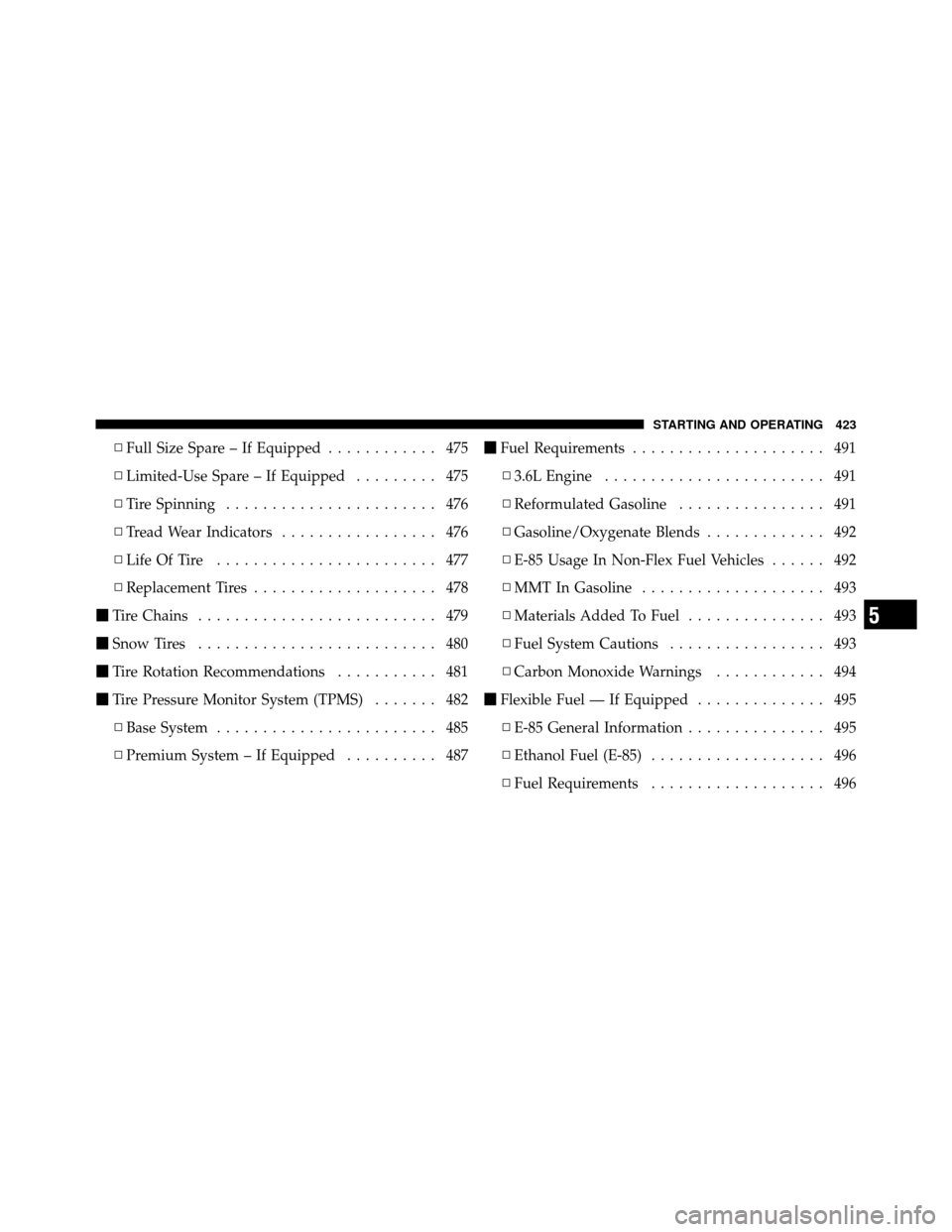
▫Full Size Spare – If Equipped ............ 475
▫ Limited-Use Spare – If Equipped ......... 475
▫ Tire Spinning ....................... 476
▫ Tread Wear Indicators ................. 476
▫ Life Of Tire ........................ 477
▫ Replacement Tires .................... 478
� Tire Chains .......................... 479
� Snow Tires .......................... 480
� Tire Rotation Recommendations ........... 481
� Tire Pressure Monitor System (TPMS) ....... 482
▫ Base System ........................ 485
▫ Premium System – If Equipped .......... 487�
Fuel Requirements ..................... 491
▫ 3.6L Engine ........................ 491
▫ Reformulated Gasoline ................ 491
▫ Gasoline/Oxygenate Blends ............. 492
▫ E-85 Usage In Non-Flex Fuel Vehicles ...... 492
▫ MMT In Gasoline .................... 493
▫ Materials Added To Fuel ............... 493
▫ Fuel System Cautions ................. 493
▫ Carbon Monoxide Warnings ............ 494
� Flexible Fuel — If Equipped .............. 495
▫ E-85 General Information ............... 495
▫ Ethanol Fuel (E-85) ................... 496
▫ Fuel Requirements ................... 496
5
STARTING AND OPERATING 423
Page 426 of 652
▫Selection Of Engine Oil For Flexible Fuel
Vehicles (E-85) And Gasoline Vehicles ...... 497
▫ Starting ........................... 498
▫ Cruising Range ...................... 498
▫ Replacement Parts ................... 498
▫ Maintenance ........................ 498
� Adding Fuel ......................... 499
▫ Fuel Filler Cap (Gas Cap) .............. 499
▫ Loose Fuel Filler Cap Message ........... 500�
Vehicle Loading ...................... 501
▫ Vehicle Certification Label .............. 501
� Trailer Towing ........................ 503
▫ Common Towing Definitions ............ 504
▫ Towing Tips ........................ 516
� Recreational Towing
(Behind Motorhome, Etc.) ................ 517
▫ Towing This Vehicle
Behind Another Vehicle ................ 517
424 STARTING AND OPERATING
Page 427 of 652
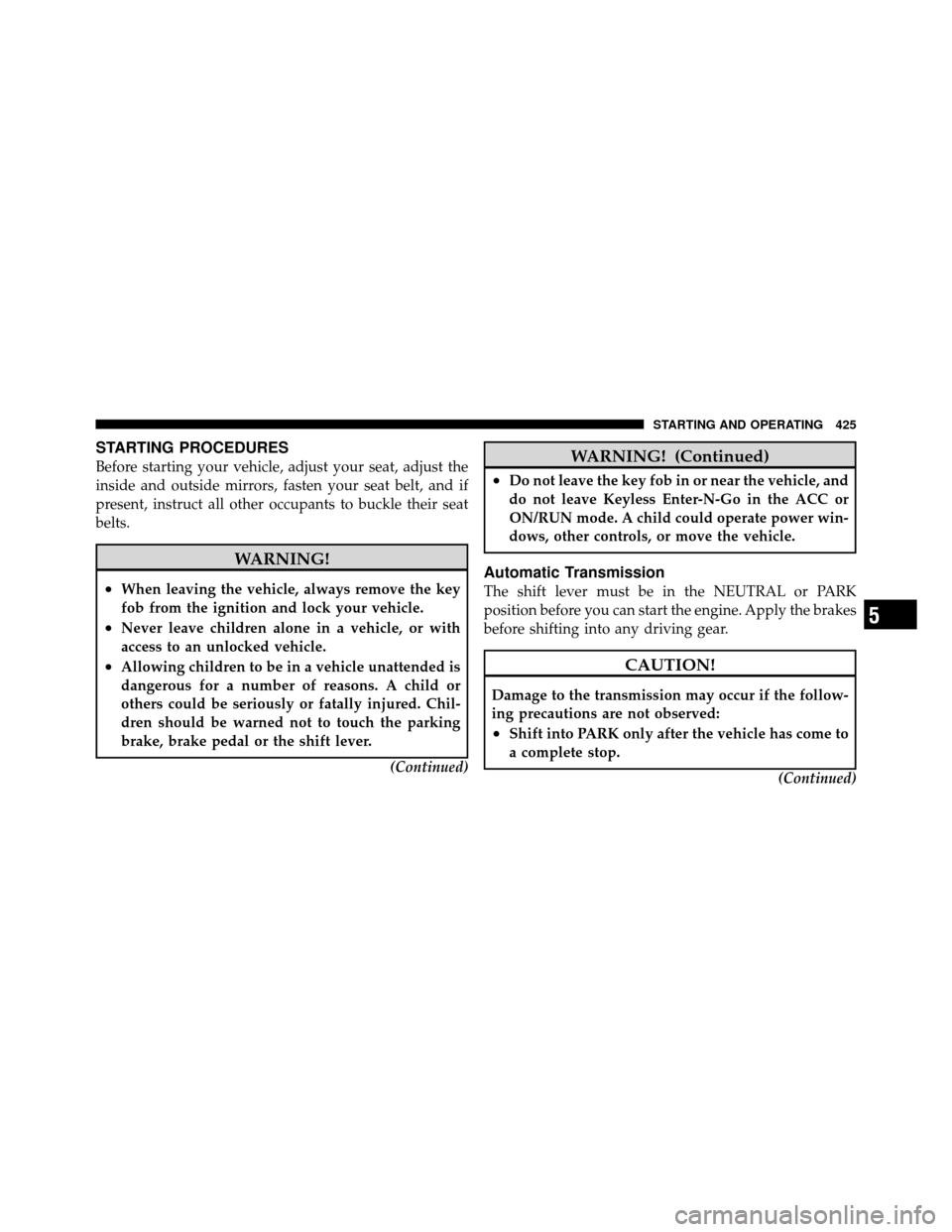
STARTING PROCEDURES
Before starting your vehicle, adjust your seat, adjust the
inside and outside mirrors, fasten your seat belt, and if
present, instruct all other occupants to buckle their seat
belts.
WARNING!
•When leaving the vehicle, always remove the key
fob from the ignition and lock your vehicle.
•Never leave children alone in a vehicle, or with
access to an unlocked vehicle.
•Allowing children to be in a vehicle unattended is
dangerous for a number of reasons. A child or
others could be seriously or fatally injured. Chil-
dren should be warned not to touch the parking
brake, brake pedal or the shift lever.(Continued)
WARNING! (Continued)
•Do not leave the key fob in or near the vehicle, and
do not leave Keyless Enter-N-Go in the ACC or
ON/RUN mode. A child could operate power win-
dows, other controls, or move the vehicle.
Automatic Transmission
The shift lever must be in the NEUTRAL or PARK
position before you can start the engine. Apply the brakes
before shifting into any driving gear.
CAUTION!
Damage to the transmission may occur if the follow-
ing precautions are not observed:
•Shift into PARK only after the vehicle has come to
a complete stop.(Continued)
5
STARTING AND OPERATING 425